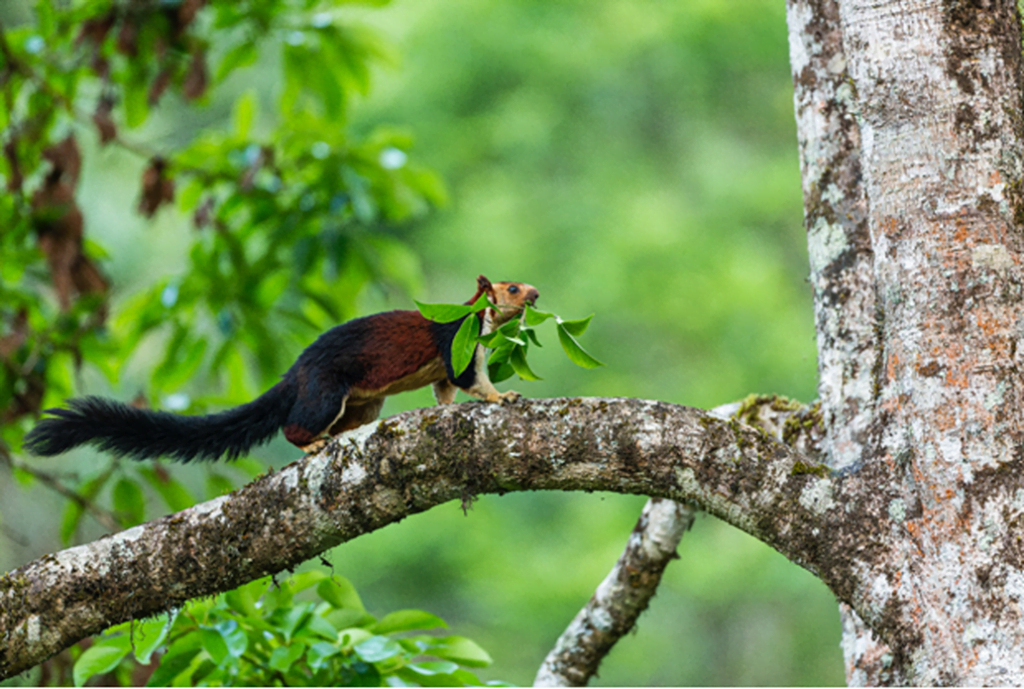Highway traffic faded away as I turned into the ghat road at the foothills of one of the Western Ghats’s loftiest ranges—the Palani Hills. A palm squirrel’s call punctuated that of the jungle babblers and sunbirds. At first, I was surrounded by trees typical of the scrub forest. A few kilometres into the journey, the canopy to my left began to drop, signalling the beginning of the ascent. The scrub forest transitioned slowly into a rainforest. Short, thorny trees with small leaves were replaced by tall ones with large leaves, the gap between the understory and canopy distinct, typical of rainforests.
By the time I began approaching Kodai town, the natural undergrowth had given way to an endless lantana grove, through which grew giant eucalyptus trees. An unusual species for this region, the eucalyptuses, with their large, smooth trunks, unbranched for half of their height, give the impression of thriving forests from afar—but I was beginning to discover that this was an illusion.
With my bag packed for the coming two months, I rolled into my field station at the heart of Kodaikanal in January 2019. I drove past the evidence of the distinct degradation to the Palani Hills’ natural habitat. It didn’t take long to see every invasive species in that region. The eucalyptus makes its appearance long before the town, followed by the acacia (locally known as wattle) and lastly the pine. These species were planted in the 1900s by the British for timber.

Landscape – Squirrel Interfaces
In the Palani region, the first signs of landscape-level takeover—a change that spreads over a landscape instead of only in selected patches—started showing by the 1960s. In 1996, a nationwide ban on tree cutting in forests was implemented. By then Kodaikanal had already declared its surroundings a reserve forest, which meant that the invasive species such as eucalyptus, acacia and pine were allowed to grow rampantly.
These landscape-level developments have no doubt been detrimental to indigenous sholas and grasslands, but they have given rise to a new matrix that allows intimate encounters with creatures that would otherwise remain unseen—a situation that could go horribly wrong if the observer lacks the sensitivity needed when in proximity to wildlife.
By the end of my time in this shola-plantation matrix of the Palani Hills, I shared special encounters with the endemic avifauna of the region and spent many memorable moments with my subject of study—the Malabar giant squirrel. As I write this, I can picture a few spots where I am bound to hear the riveting call of the rodent, see a pair chase one another or find a lone individual gnawing away at a piece of fruit. I was blessed to develop this familiarity, and in as little as two months, the Palani Hills began to feel like a second home.
On a routine visit, a team from the Indian Institute of Science Education and Research, led by Professor Nandini Rajamani, under whose guidance I worked on my thesis, spotted the iconic nests of the giant squirrel in the eucalyptus plantations along the main roads of the Palani Hills. They also noticed small hints of a metamorphosis at the landscape level in the same region.

As per our understanding, the eucalyptus plantations had not only threatened the survival of the squirrels but also disturbed the landscape at its roots, by outgrowing the natural shola forest in this region. Left undisturbed, Malabar giant squirrels will build their nests, called dreys, in the foliage-dense crowns of the shola trees. Several dreys are built in close proximity to each other. While the mother hides the pup in one, the rest are used as decoys to fool predators. The squirrel rotates the nursery nest in order to reduce the chance of ectoparasites harming the pup. Around the southern Western Ghats, breeding season runs from October to November, when the female gives birth to a single pup.
During my field work, though I couldn’t find any squirrel nests in my plots, I did spot them along the road while driving to my study sites. Except for a handful, the rest were in plantations. Although most looked abandoned, there were a few fresh ones, confirming not just the rodent’s presence but also the fact that they had adapted well enough to these landscapes to begin nesting.

Close Encounters
Bishwajit Banerjee, a long-term Kodaikanal resident with farm properties in the Perumpalam and Kombai regions, echoed these findings. Kombai lies in the heart of the biodiverse Pallangi region, around 9 kilometres from Kodaikanal town. At an altitude of 1,650 metres, it is known by birders as a hotspot in the Palani Hills. It is home to birds, butterflies and some larger mammals, like elephants, boars, leopards and the Malabar giant squirrel.
Today’s Pallangi Kombai is also home to orchards with electrical fencing and CCTV cameras placed on the edge of the plantations. Much of the old forest has disappeared, just like in the rest of Kodaikanal and the Palani Hills. Yet, somehow, the animals thrive here.
‘Most, if not all, of the farmers who own our surrounding land have declared war on the animals, including on the giant squirrels,’ Banerjee says. ‘Thus, they all take shelter on our farm. The elephants damage every tree, the leopards pick up dogs and the bushy-tailed squirrels help themselves to every fruit in our orchards. It is not uncommon to find them digging into the jackfruits from the tree next to the building or plucking avocados beside the main path. While we lose avocados and jackfruits to these hungry rodents, nothing replaces the feeling of observing them up-close, in their element.’

Adapting to changing landscapes
My thesis study showed that amongst the three or four species of plantation trees, the squirrel seemed to favour the eucalyptus the most (67% to be precise). Perhaps the eucalyptus’s stable branching is conducive for nests, while their height discourages ground-dwelling predators. Photographs confirmed that the dreys were made of eucalyptus twigs and leaves, despite there being shola trees around the plantations. The fact that the squirrel didn’t need to use material from the shola shows a higher level of interaction with—perhaps even a dependency on—the invasive species. What we considered an incredible discovery was simply the squirrel following its nesting instincts.
While the tree canopy composition in plantations was clearly dominated by the invasive species (eucalyptus and pine in some cases, and eucalyptus and acacia in others), the undergrowth revealed some surprises. Old lantana was common in the understory of a heavily disturbed patch. However, many of the plots I studied (including the ones with nests) had two things in common. The first, a healthy presence of shola saplings on the forest floor. This is a clear indication that sholas are reclaiming the space they lost to the invasive giants. The second, the nest plots were located fairly close to natural shola forests, with no agricultural fields in the vicinity—indicating that the squirrels chose eucalyptus as nesting material despite having their original habitat around. This was interesting to observe.
Sholas are also known for their endemic avifauna. Birds like the black-and-orange- and Nilgiri flycatcher, white-bellied sholakili and Palani chilappan are some of the most prominent members. Chilappans, being very adaptive, can be seen quite easily in disturbed patches. Flycatchers and sholakili, on the other hand, haven’t fared so well and are only seen in small pockets of shola habitat. It is a surprise that one of the most conspicuous species, the Malabar giant squirrel, has adapted so well.

Photo: Sanjay Prasad Ganguli
The Conservation Question
The giant squirrel has fared brilliantly not only against the invasive trees but also with the species that planted them. Inhabitants living in and around Kodaikanal document increasing encounters with the rodent.
‘Our home, in a village on the fringe of Kodaikanal, is being increasingly visited by wild animals in recent years,’ says resident Lathika George, a writer and environmentalist. ‘We were delighted to find a Malabar giant squirrel on our glassed-in veranda one morning. It scampered in through the open door and perched on a ledge at the far end. With a velvety rust-red coat, it was a beautiful sight and, up-close, larger than I expected. I have spotted them on walks in the sholas, but to have one calmly looking across at me, just a few feet away, was a special experience. They are typically shy and skittish, but this one was not—not put off by my presence or even by our cats stalking him. I guess he has made his peace with humans.’
Incidents like this shed light on the knife’s edge that conservationists must tread on. On the one hand, the presence or unchecked growth of exotic species can threaten to invade and overpower indigenous flora and fauna. On the other hand, it is possible for the same exotic-turned-invasive species to benefit the local wildlife.
In the case of the Palani Hills, we cannot turn a blind eye to plus points and eradicate the eucalyptus as an invasive species that must be removed. This may be far more destructive than helpful for creatures like the Malabar giant squirrel.
We must never forget that nature will find a way even when we haven’t. She is far more adaptive than we give her credit for.




